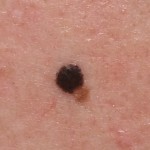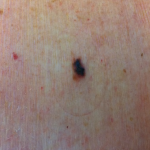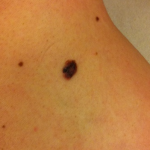Malignant Melanoma
Every year, over 76,000 patients in the US are diagnosed with malignant melanoma. Nearly 10,000 die every year. The cancer can spread to other parts of the body by metastasis, making malignant melanoma the most serious form of skin cancer. However, if diagnosed early, the chance of cure is over 95%. Thus, early diagnosis is essential.
Use our dermatology search engine to screen your moles
Malignant melanoma often presents as a “mole” that is different. It may be different due to an asymmetrical shape, different color, larger size, or a combination of features. Some melanomas can be fast growing and have a worse prognosis. Soreness is also a warning sign.
About 30% of melanomas arise from existing moles. Most commonly, they occur as a new or changing mole in apparently healthy skin. A melanoma can develop anywhere on the body, but they usually appear on skin sites with a history of high UV exposure. In people with darker skin tones, it is not uncommon for melanomas to develop in places not exposed to the sun at all – the palms, soles, or under the nails. In men, melanomas most often occur on the trunk, back, limbs, head, and neck. In women, melanomas most commonly develop on the lower legs.
The prognosis for a malignant melanoma depends on how thick the tumor is. A melanoma less than 1 millimeter thick gives a good prognosis, with nearly 100% survival. More than 4 millimeters thick gives a poorer prognosis. The thinner the melanoma, the better. Soreness and ulceration can indicate that the melanoma has entered the blood vessels.
Use our dermatology search engine to screen your moles
Signs of a malignant melanoma:
- Large, brownish stain containing darker portions
- Mole that suddenly changes color, grows, bleeds or itches
- Skin lesion with an irregular edge
- Skin lesion with elements of different colors such as white, blue, or blue-blacks
- Dark lesions on the palms, soles, fingertips, or toes
- Lumps or changes in the lining of the mouth, nose, or genitals
Sources
U.S. Cancer Statistics Working Group. United States Cancer Statistics: 1999–2012 Incidence and Mortality Web-based Report. Atlanta: U.S. Department of Health and Human Services, Centers for Disease Control and Prevention and National Cancer Institute; 2015. Available at: https://www.cdc.gov/cancer/dcpc/data/
AIM at Melanoma Foundation. Melanoma Stats, Facts, and Figures. Available at: https://www.aimatmelanoma.org/about-melanoma/melanoma-stats-facts-and-figures/.
American Academy of Dermatology. Melanoma. Available at: https://www.aad.org/diseases/skin-cancer/melanoma-overview
National Cancer Institute. SEER Stat Fact Sheets: Melanoma of the Skin. Available at: http://seer.cancer.gov/statfacts/html/melan.html









